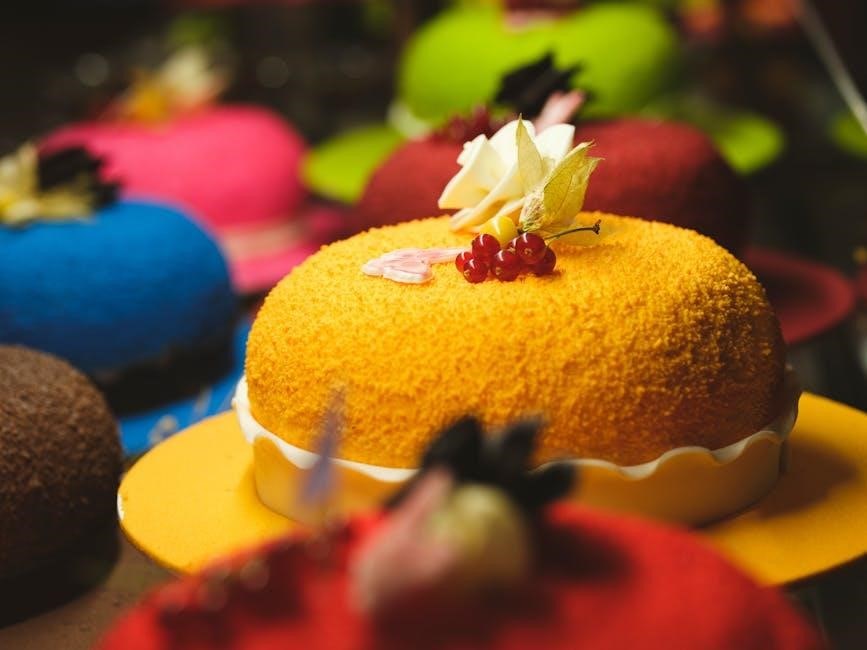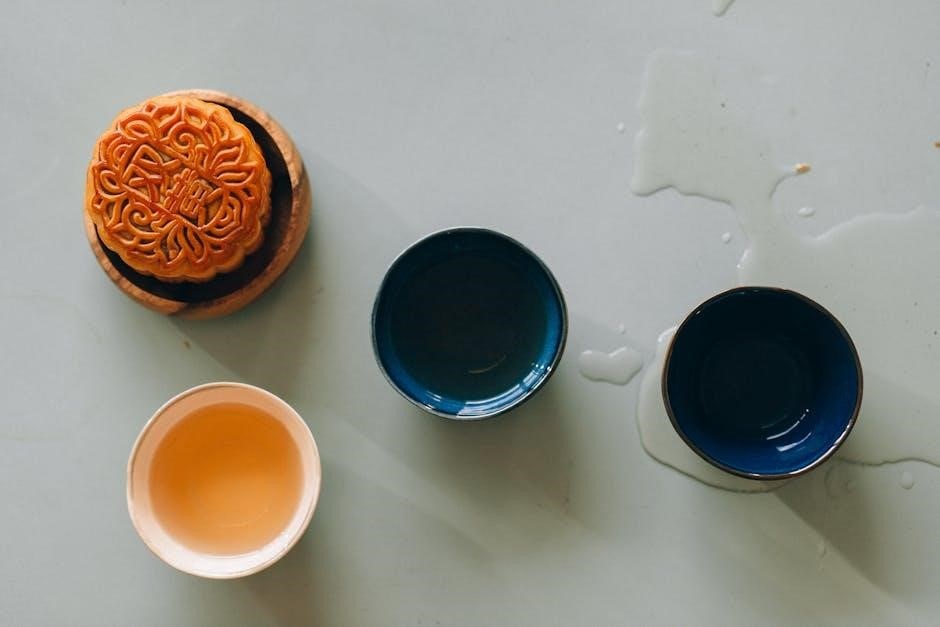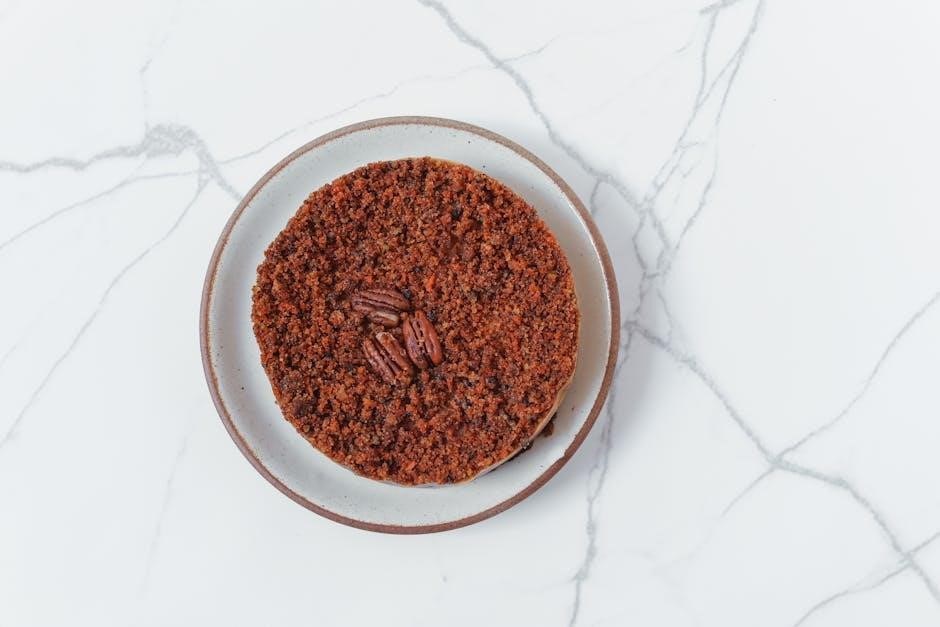Cutting a round cake evenly is an art that enhances presentation and ensures fair portions. Essential tools and techniques make the process efficient and visually appealing.
Importance of Proper Cake Cutting
Proper cake cutting ensures even portions, enhancing both presentation and guest satisfaction. It prevents waste and makes serving efficient, especially at events. A well-cut cake maintains its visual appeal, reflecting the effort put into baking and decorating. Even slices also ensure fairness, making every guest feel valued. Additionally, precise cutting highlights professionalism, particularly in formal settings like weddings or catered events. By mastering this skill, you can elevate the overall experience and make your cake the centerpiece of any celebration.
Key Considerations for Cutting Round Cakes
When cutting a round cake, consider the cake’s height, diameter, and decorations. Ensure the cake is completely cooled to avoid crumbling. Use a serrated knife for clean cuts and a cake stand for better visibility. Measure evenly to maintain portion consistency. For tall cakes, horizontal slicing may be necessary. Decorations should be removed beforehand to prevent interference. The number of guests and serving size will dictate the number of slices. Proper planning ensures a smooth, efficient cutting process, making the event stress-free and enjoyable for everyone involved.
Tools and Equipment Needed
The right tools ensure precise and efficient cake cutting. A long serrated knife is essential for clean, even slices. A cake stand or turntable allows easy access and visibility. Serving utensils like a cake server or offset spatula help lift and transfer slices neatly. Optional tools include a measuring guide for portion control and a pastry brush to remove loose crumbs. Durable cutting boards or mats protect surfaces from damage. Having these tools organized streamlines the process, making cake cutting a breeze for any occasion. Proper equipment enhances both the presentation and the serving experience of your round cake.

Essential Tools for Cutting Round Cakes
A serrated knife ensures clean cuts, while a cake stand or turntable provides stability and visibility. Serving utensils like a server or offset spatula enhance efficiency and presentation.
The Best Knives for Cutting Cakes
A serrated knife is ideal for cutting round cakes, as its teeth create clean, smooth cuts. A long, thin blade allows for precise control, while an offset knife minimizes crumbs. For tall cakes, a cake slicer with a long, rigid blade ensures even horizontal cuts. Dull knives can tear the cake, so sharpness is crucial. Non-stick coatings prevent the knife from sticking to the cake, making the process easier. Regularly cleaning and maintaining the knife ensures optimal performance. Using the right knife enhances the appearance and consistency of each slice, making serving a seamless experience.
Using a Cake Stand or Turntable
A cake stand or turntable is essential for efficient and even cutting of round cakes. It elevates the cake, making it easier to access from all sides without moving the cake itself. A turntable allows you to rotate the cake effortlessly, ensuring precise cuts and uniform slices. This tool is particularly useful for large gatherings, as it streamlines the serving process. Additionally, it enhances presentation, making the cake a visually appealing centerpiece. A sturdy stand or turntable is a must-have for any cake-cutting task, ensuring stability and professionalism in every slice.
Serving Utensils for Efficient Cutting
Efficient cake cutting requires the right serving utensils, such as a sharp serrated knife, a cake server, and an offset spatula. A serrated knife ensures clean, precise cuts, while a cake server or offset spatula helps lift and transfer slices without breaking them. These tools are designed to simplify the process, ensuring even portions and neat presentation. Proper utensils not only enhance the cutting experience but also make serving easier, especially for large gatherings or special occasions. Investing in quality serving tools guarantees professional-looking results and stress-free cake serving.

Preparing the Cake for Cutting
Cooling the cake ensures stability, while leveling creates an even surface for slicing. Removing decorations beforehand prevents damage and allows for clean, precise cuts.
Cooling the Cake Properly

Proper cooling is essential for clean slicing. Let the cake cool in its pan for 10-15 minutes to set the structure, then transfer it to a wire rack to cool completely. This prevents sogginess and ensures even texture. For larger cakes, cooling racks with good airflow are ideal. Avoid refrigerating until fully cooled, as this can trap moisture. A completely cooled cake is firmer, making it easier to handle and slice evenly. Proper cooling also helps prevent crumbling and ensures smooth, professional-looking cuts. Allow at least 1-2 hours for small cakes and longer for larger ones before cutting.
Levelling the Cake for Even Slicing
A level cake ensures even slicing and professional presentation. Place the cooled cake on a flat surface and use a serrated knife to gently saw off any uneven areas. Check the cake from all sides to confirm it’s level. For precision, you can use a cake leveller tool, which helps achieve a perfectly even surface. This step is crucial for preventing wobbly slices and ensuring uniform portion sizes. A level cake also makes it easier to stack layers or apply frosting evenly, guaranteeing a polished final result for any occasion.
Removing Decorations Before Cutting
Before cutting, remove all decorations to ensure clean, even slices. Gently take off toppings like fondant, buttercream flowers, or fresh fruit. Use a flat tool or spatula to lift large decorations, while small embellishments can be carefully picked off by hand. Place decorations on a separate plate or tray to avoid damaging them. This step prevents uneven cuts and keeps the cake surface smooth for slicing. Once the cake is cut, you can reattach the decorations to the slices for a polished presentation. This ensures both functionality and visual appeal.

Basic Techniques for Cutting Round Cakes
Basic techniques for cutting round cakes include radial slicing, grid patterns, and horizontal layering. These methods ensure even portions and a clean, professional presentation every time.
Radial Cutting Method
The radial cutting method involves slicing the cake from the center outward, creating even, wedge-shaped portions. Start by placing the knife at the cake’s center and cutting straight to the edge. Continue making parallel slices around the cake, rotating it slightly after each cut for consistency. This technique ensures uniform slices and a clean presentation. For larger cakes, a serrated knife and a turntable can help achieve smooth, precise cuts. The radial method is ideal for events where guests serve themselves, as it maintains the cake’s integrity and provides easy access to each slice.
Grid Cutting Method for Larger Cakes
The grid cutting method is ideal for larger round cakes, ensuring uniform portions and efficient serving. Start by making parallel vertical cuts across the cake, spacing them evenly. Then, make horizontal cuts perpendicular to the vertical ones, creating a grid pattern. This technique works best with a serrated knife and a turntable for easy rotation. For extra precision, mark the cake with toothpicks or a skewer to guide your cuts. The grid method is perfect for large gatherings, as it allows for quick, consistent slicing and minimizes waste.

Horizontal Slicing for Tall Cakes
Horizontal slicing is a practical method for cutting tall round cakes, allowing you to create even layers for serving. Place the cake on a sturdy stand or plate and use a long serrated knife to slice horizontally across the middle. For stability, you can insert wooden dowels or skewers to hold the layers steady. This technique is especially useful for multi-tiered cakes, as it prevents the cake from toppling and ensures clean, even portions. Always slice in a smooth, sawing motion to maintain control and achieve precise cuts.
Portion Control and Serving Tips
Portion control ensures every guest enjoys an equal share, while serving tips like adjusting slice sizes for events and using cake servers enhance presentation and efficiency.
Measuring Even Portions
Measuring even portions ensures fairness and consistency when serving round cakes. Use a serrated knife and cake server for clean cuts. Start by marking the cake into equal sections using a toothpick or knife tip. For larger cakes, a grid cutting method works well. Always cut in a smooth, gentle motion to avoid crumbling. Cool the cake thoroughly before slicing to maintain structure. Using a turntable can help access all sides evenly. This method guarantees uniform slices, making every portion visually appealing and fair for guests.
Adjusting Slice Sizes for Different Events
Adjusting slice sizes ensures your round cake meets the needs of various events. For formal gatherings like weddings, larger slices are ideal, while smaller slices suit parties or buffets. Use a serrated knife to create thinner or thicker cuts as needed. Consider the number of guests and serving preferences to determine portion sizes. A cake server or offset spatula can help portion slices neatly. For casual events, bite-sized pieces are practical, while taller cakes may require horizontal slicing for even distribution. This flexibility ensures every event is catered to perfectly, maintaining both presentation and guest satisfaction.
Calculating the Number of Servings
Accurately calculating servings ensures your round cake meets event demands without waste. Measure the cake’s diameter and height to estimate volume. A standard slice is 1-1.5 inches wide. For larger events, smaller slices (1 inch) yield more portions, while formal gatherings may require larger slices (1.5 inches). Use the grid cutting method for precise, consistent portions in larger cakes. Consider frosting and decorations when estimating, as they can affect slice size. This method ensures fairness and efficiency, making your cake cutting process seamless and stress-free for any occasion.
Advanced Tips for Perfect Slices
Mastering advanced techniques ensures pristine, professional-looking slices. Use a cake server or offset spatula for smooth cuts and arrange slices attractively on a serving platter for enhanced presentation.
Using a Cake Server or Offset Spatula
A cake server or offset spatula is essential for achieving clean, precise slices. The server’s curved edge glides smoothly under slices, while the spatula’s angled blade allows for even lifting. For tall cakes, use the spatula to stabilize layers during cutting. Position the tool flush against the cake to prevent crumbling. Wipe the blade between cuts to ensure debris-free servings. These tools not only enhance presentation but also make serving efficient and mess-free, especially for multi-tiered or intricately decorated cakes.
Arranging Slices for Presentation
Arranging cake slices for presentation is key to creating a visually appealing display. Start by placing the cake on a stand or turntable to elevate it. Slice and arrange the pieces in a fan-like pattern around the base of the cake, ensuring symmetry for a polished look. Garnish with fresh flowers, berries, or dust with powdered sugar for extra flair. For variety, alternate slice sizes or angles to add visual interest. Use a small bowl to set aside crumbs or uneven pieces. This method ensures a stunning and professional presentation, making every slice look as inviting as the whole cake.
Garnishing Slices for Enhanced Appeal
Garnishing cake slices adds a finishing touch that elevates their visual and culinary appeal. Fresh flowers, berries, or edible decorations like sprinkles or chocolate shavings are popular choices. Lightly dusting with powdered sugar or cocoa powder creates a elegant look. For a fruity twist, top slices with a dollop of whipped cream and a fresh fruit piece. Drizzling with chocolate or caramel sauce adds both flavor and visual flair. Consider matching the garnish to the cake’s theme or flavor profile for cohesion. These small details transform each slice into a delightful and Instagram-worthy treat, making your presentation truly memorable.
